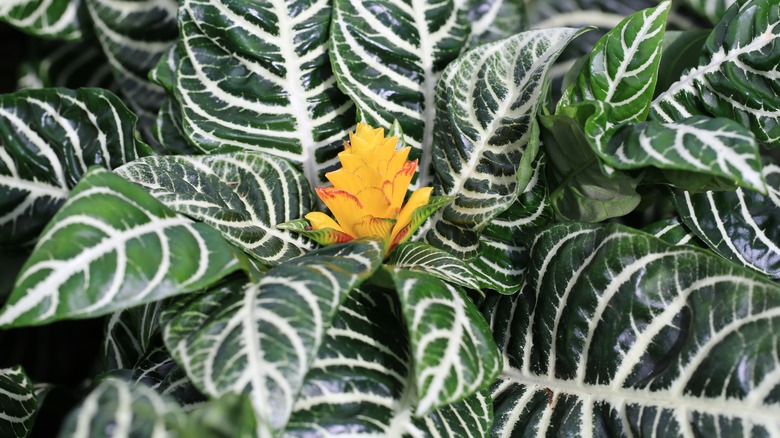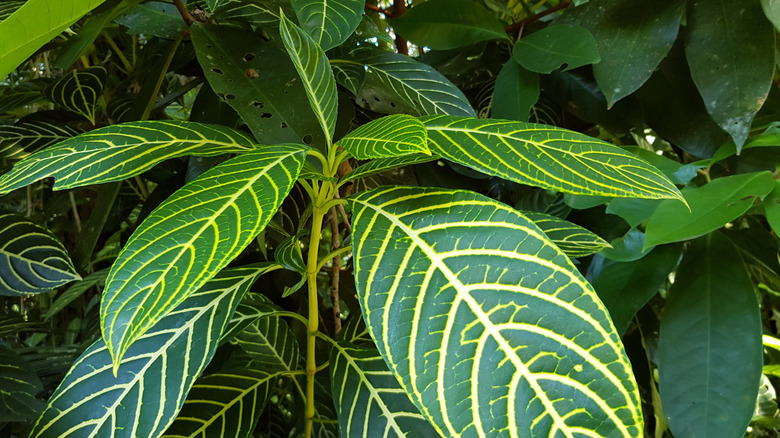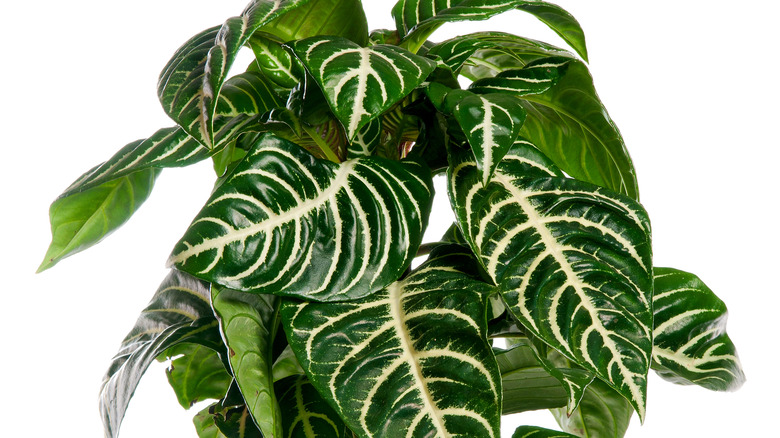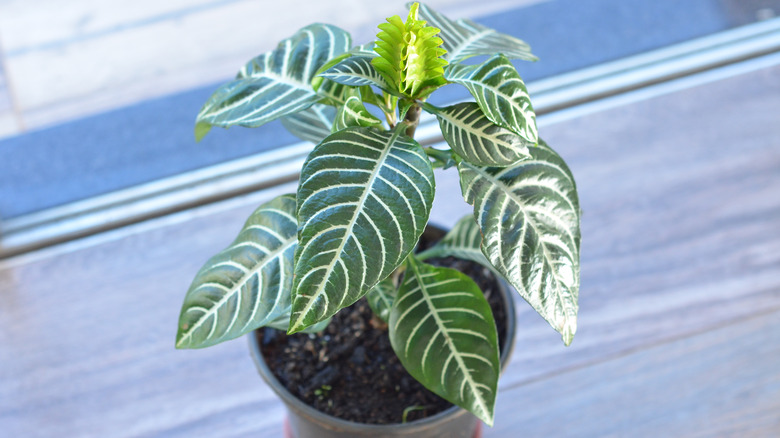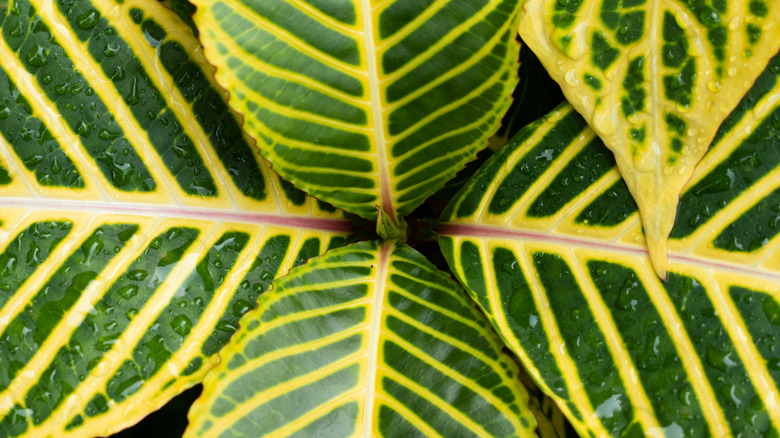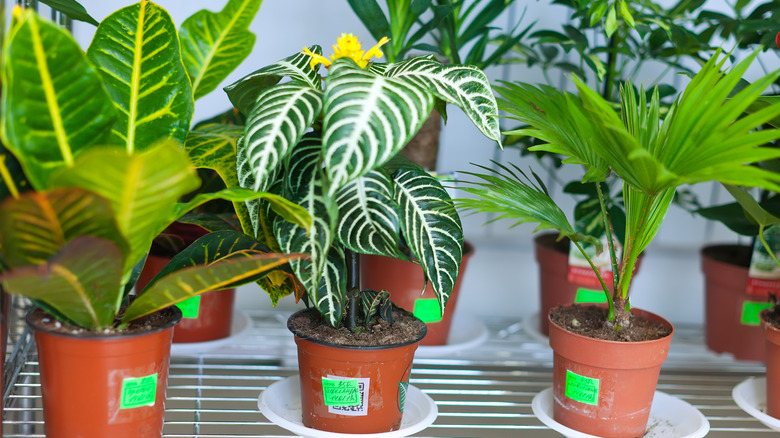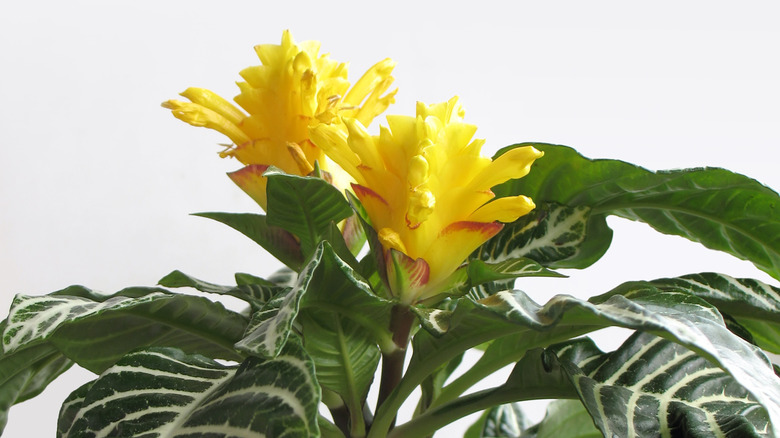Zebra Plant: Everything You Should Know Before Planting
The zebra plant, or aphelandra squarrosa, is popular for its striking leaf design and yellow flower bracts. With dark, jewel-toned green leaves, stark white variegation, and potential to bloom in the summer and fall, this plant is a stunning addition to your indoor garden. Native to Brazil, zebra plant is temperamental, but rewarding for a seasoned plant lover up to the challenge of getting it to bloom (via The Spruce).
While zebra plant is high-maintenance, and certainly not beginner friendly, it can add a bold accent to your home if taken care of properly. Additionally, this plant is completely non toxic to pets and humans, so you can take solace in the lack of an impending vet trip, according to Bloomscape.
Note: This article is about the aphelandra squarrosa zebra plant. There is another plant, calathea zebrina, that is also called the zebra plant. The calathea is a beautiful plant and arguably easier to cultivate than the aphelandra squarrosa, but it will not be covered in this article; neither will haworthia varieties.
How to use zebra plant in garden
The zebra plant's specific set of needs do not lend well to being planted or brought outdoors. The plant is tropical, originating from Brazil, and needs its native conditions mimicked as closely as possible. They need to be kept at 60% to 70% humidity while never being exposed to temperatures below 60 degrees, according to The Spruce — a condition that is not readily met in most of the U.S.
Even if those needs can be met organically outside, zebra plants must also have indirect shade and avoid direct sunlight, as they grow naturally in dense canopies. These needs can possibly be met in zones 11 or 12, such as South Florida or Hawaii. To that end, Southern Living says gardeners living in South Florida may have success planting the zebra plant outside. Provide it with dappled shade and a well-draining soil, and expect blooms in the late summer to early fall.
How to grow zebra plant
One way you can obtain a zebra plant is through propagating its leaves. An actual zebra plant is not that expensive, so there are very few people who sell leaf cuttings — meaning, your best bet is to cut a stem for yourself. To get a cutting from a zebra plant, use sharp, sterile scissors or garden shears. Cut off a 2 to 3 inch piece of one of the plant's offshoots.
Once you have obtained your cutting, it's time to propagate your plant. The Spruce recommends dusting the exposed ends of your cutting with rooting powder to aid in the propagation process. Fill a pot with moist soil, and insert the dusted end of your cutting into the dirt. If your room is cooler than 70 degrees, place the pot on a heating mat to encourage the cutting to root. You will want to keep your cutting in very humid conditions; either keep it next to a plant humidifier, mist frequently, or propagate in a covered terrarium. Expect roots to form after about a month — new leaves should signify a successful propagation. Repot your zebra plant once it has rooted.
How to care for zebra plant
The most important thing to consider when caring for a zebra plant is that you mimic its natural conditions as much as possible. It will not adapt well to diversions from its naturally tropical climate, and you should take care to replicate it. Zebra plants grow organically in thick, tropical canopies. To mimic this, provide them with bright indirect light to partial shade, per Bloomscape. Be careful not to expose them to direct light, as it will scorch their leaves. Complete shade will keep them from blooming.
Your zebra plant will want consistently moist soil, but too much water can lead to wilting. Let your plant partially dry out before watering, and then water heavily. A good rule of thumb is to weigh your plant with your hands. Feel how heavy your plant is when freshly watered; when it gets lighter than that, it's likely time to water. Drench your plant with lukewarm water and let it drain completely — do not allow it to sit in a wet saucer. Water only the soil, as watering the leaves can lead to crown rot.
Keep your plant consistently humid, ideally with a humidifier. Avoid placing it under or next to vents or other air sources. Fertilize your zebra plant to encourage blooming. During growing months, fertilize bi-monthly with a high quality blooming fertilizer that is suitable for houseplants.
Varieties of zebra plant
There are a handful of zebra plant varieties to choose from when looking to bring home the flowering houseplant. The differences are subtle, and very few require unique care; there are just slight visual deviations. It is still a good idea to know which type to look for, though.
Here are just a few varieties from Florgeous:
-
Aphelandra squarrosa "Dania" — This variety comes from Denmark, is compact, and sports a creamier colored variation with maroon stems.
-
Aphelandra squarrosa "Red Apollo" — Though it is more sensitive and less likely to bloom, this variety is distinguished by its reddish-brown leaves and yellowish accents.
-
Aphelandra squarrosa "Brockfeld" — A German variety, this zebra plant has lighter leaves, yellow variegation, and is smaller than most of its counterparts.
-
Aphelandra squarrosa "Snow White" — This variety gets its name from its white speckled variegation, which looks like snow against its darker green leaves.
-
Aphelandra squarrosa "White Wash" — A cross between the regular zebra plant and Snow White, this variety gets its name from the slight white glaze on its leaves.
How to repot zebra plant
Zebra plants are not averse to being root bound, making repotting an infrequent responsibility, per Epic Gardening. If it is necessary to repot your zebra plant, do so in the beginning of its growing season in the early spring, and absolutely do not repot it during dormant months.
To repot, begin by removing the zebra plant from its current pot and gently breaking up the roots, removing as much old soil as possible. Epic Gardening says most zebra plants will do well in a 5 to 6 inch pot, and you should only go up 1 inch for a new pot. They prefer a slightly acidic soil, with a pH around 5.6 to 6.0. You can test this with a pH meter. The soil also needs to be well draining, so consider using an African violet potting mix, or adding sand, peat moss, coco coir, and/or perlite to a regular soil. Add your zebra plant to its new home, fill with soil, water thoroughly, and let drain completely.
Encouraging your zebra plant to bloom
The biggest challenge of a zebra plant is getting the plant to bloom. You must meet a very specific set of conditions, and even then it may not be enough to get a flower. The plant will only bloom for six weeks, meaning the window to achieve blooming is slim. There are some ways to encourage blooming, though, and possibly get your plant to bloom twice in a season!
According to Epic Gardening, you can place your plant in a cooler location during the winter and bring it back to a warm place in the spring to encourage flower growth. It is also a good idea to place the plant by an intense, but indirect source of light. Three months of this intense light will encourage blooming.
If your plant does bloom in the summer, cut back the flower bract after its six weeks of flowering. This will lead to the possibility of a second bloom in the fall.
